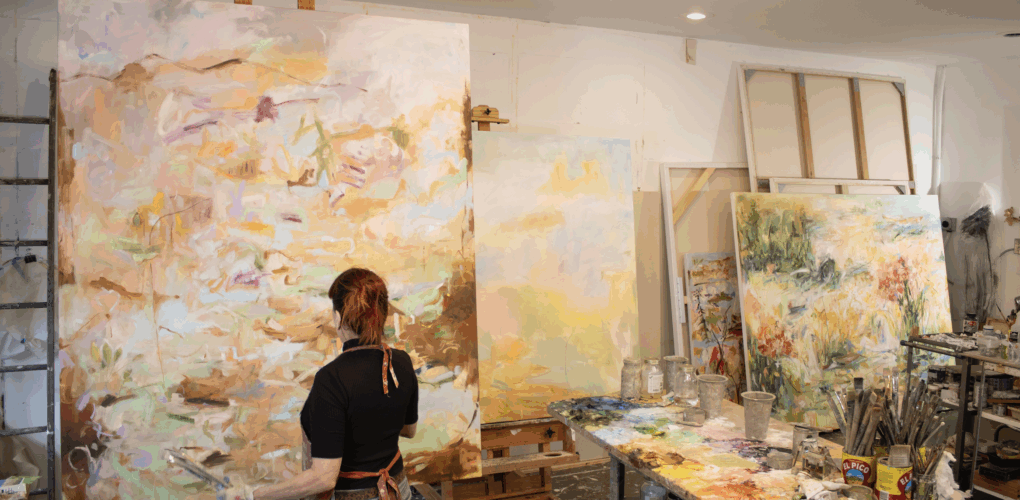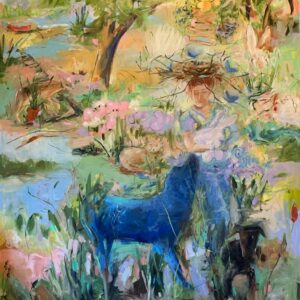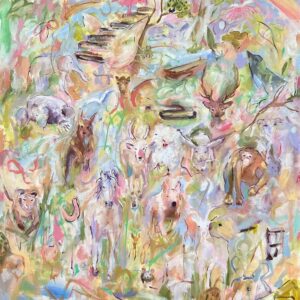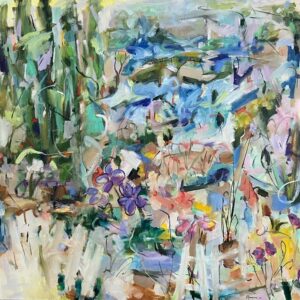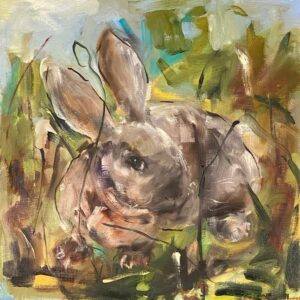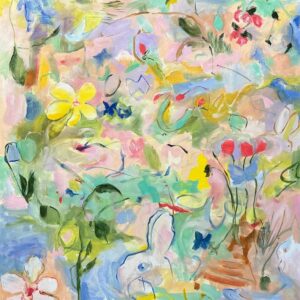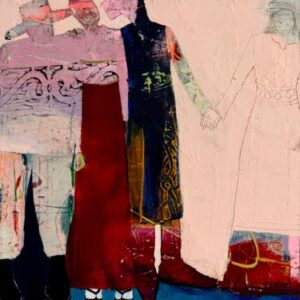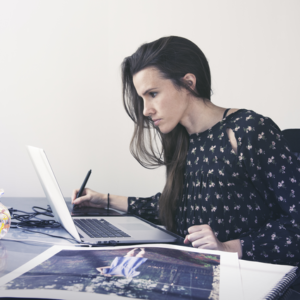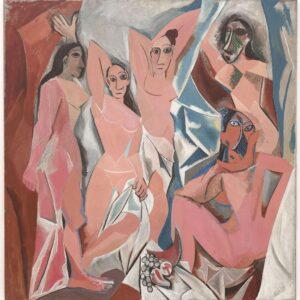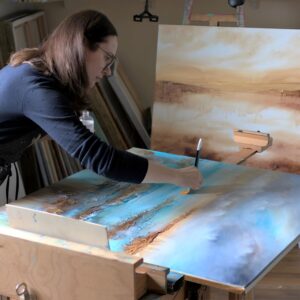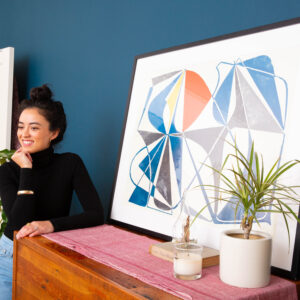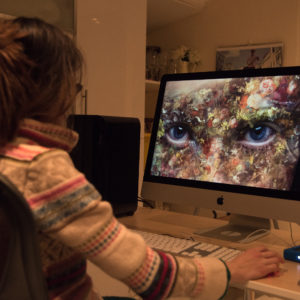One to Watch
 Nature, Abstraction & Storytelling with Artist Renée Zangara
Nature, Abstraction & Storytelling with Artist Renée Zangara
Delicate greens and soft pinks ebb and swirl together into Renée Zangara‘s mystical scenes of nature, which shimmer with abstraction.
Flowers, animals, and tree branches emerge from swathes of soothing color, fleeting symbols amidst the empyrean compositions Renée creates. Renée received her BFA from Marylhurst University, and she has an extensive exhibition history throughout the Pacific Northwest. Her work has also been featured at the Portland Art Museum, Portland International Airport, and on Oregon Public Broadcasting’s Emmy Award-winning series, Oregon Art Beat. Find out why ethereal naturalist Renée Zangara is One to Watch.
Tell us about who you are and what you do. What’s your background?
I am a visual artist residing in the Pacific Northwest and an active member of Portland, Oregon’s arts community. My contributions to local arts initiatives include serving on selection committees for the Regional Arts and Culture Council’s grant and public art programs and working as a press operator during fundraising events for the Portland Institute for Contemporary Art.
Before immersing myself in the realm of fine art, I worked as a window dresser. In hindsight, this profession proved invaluable to my art practice. Designing immersive retail displays taught me how spatial arrangements shape experience, a skill that now informs the way I approach art installations. Dressing mannequins provided lessons in color, texture, and pattern combinations—principles that continue to influence the organization of my painting compositions. These are two examples of the many lessons I’ve carried forward from that trade. It was during those years that I became captivated by painting and began taking night classes at a local university. Over time, my passion deepened until my obsession with art making became a way of life. As a side note, I’m in good company—several renowned painters, including Salvador Dalí, Willem de Kooning, Andy Warhol, and Jake Berthot, also spent time working in the visual display arena.
What does your work aim to say? What are the major themes you pursue in your work?
My paintings are invitations to journey into a visual world that reflects my deep respect for Mother Earth and for all the creatures and energies that inhabit our planet. I visually elaborate on the continuous interplay between nature and industry, and I share my devotion through artmaking. I often compose scenes featuring seemingly incongruent imagery — an industrial barge drifting along a quiet river, a coyote standing just beyond a window, or a stack of books resting on a table. While these subjects may appear unrelated at first glance, they share a connection, much like the shifting perspectives we encounter in daily life. In my work, these moments coexist, offering a reminder that our personal “viewfinders” simply frame life in continuous motion.
I draw inspiration from stored memories, personal experiences, singular events, and mythic stories. My paintings often merge these narratives with images drawn from my surrounding environment—a landscape that includes a river, river industry, railroad and vehicle bridges, woodlands, and flower gardens. I incorporate domesticated and wild animals, and—when compelled to do so—I invoke artistic license to include exotic and fanciful creatures.
One example is a series of four paintings titled Autumn, Winter, Spring, and Summer. The paintings were based on the animals assigned to the seasons in the Chinese Zodiac. I placed the animals amidst landscapes that were inspired by the river and wooded terrain surrounding my studio. This project allowed me to merge my enduring fascination with oracles, animal symbolism, and the natural environment, making it both engaging and personally rewarding.
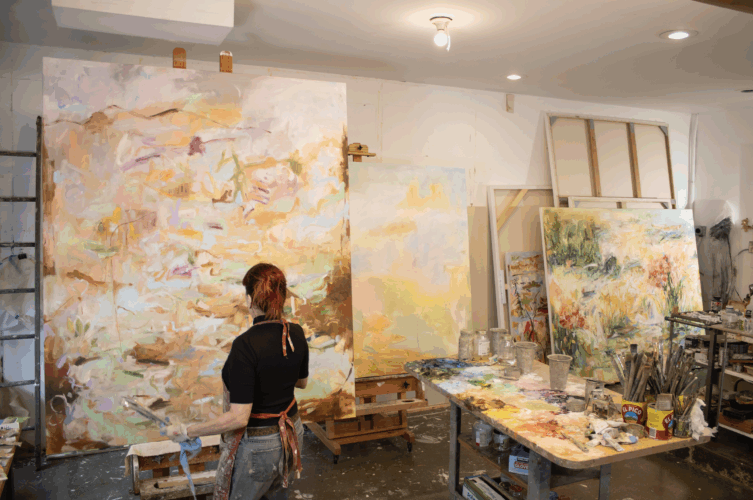
Can you walk us through your process for creating a work from beginning to end?
My process often begins with an object, image, or scene that captures my attention. Sometimes I’m compelled to assign meaning to the inspirations, other times they evoke a memory that I feel enticed to explore. Objects, images, and scenes are prompts that motivate me to consider the steps required to create a painting. Before starting a painting, I think about scale, materials, color, composition, and content. Once in motion, I enter what I think of as “the gap” or “the zone,” a suspended, ethereal space where the work unfolds intuitively. When I emerge from the gap, I assess what has taken shape on the canvas and make decisions on how to move forward. I see these interactions as a dialogue between me and the painting itself. The exchange informs my decisions that ultimately transform a blank canvas into a painting.
Who are your biggest influences and why?
I am most inspired by those who are enamored with and committed to a purpose that fuels their lives. They wake with intention and move as though they are on a mission. They’re enthused, curious, fearless, and obsessed. From my long and varied list of influences, a few who embody this spirit are: Painter Susan Rothenberg, for her unwavering discipline to be in her studio every day. The steadfast practice propelled her mastery. I will forever be a fan.
Musician Tom Waits, for his unique perspective on life. His work is a world unto itself—raw, strange, and distinctly beautiful. Tom has expressed his beliefs about the creative whispers he pays close attention to. I, too, am attuned to the subtle murmurings.
Painter Elisabeth Cummings: In 2019, I discovered Elisabeth’s work via social media. I recognized a kinship between our paintings and our painting approach. Elisabeth and I live on different continents, yet we share a reverence for the land, the various offerings nature supplies, and a dedicated fascination with paint, texture, and color. I am fortunate to have found her work and added her to my list of outstanding artists.
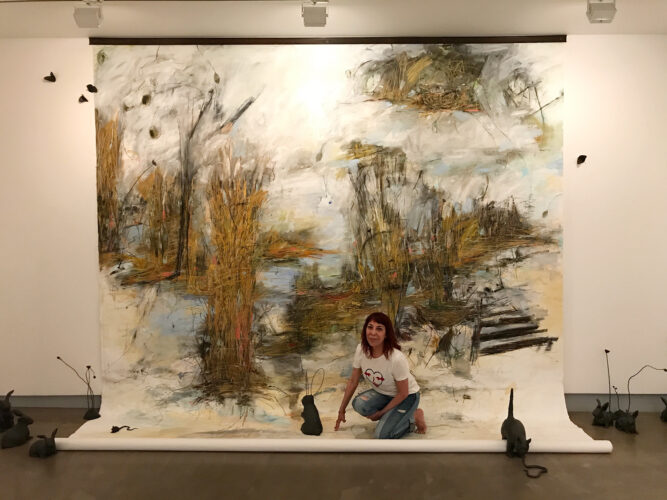
How do you hope viewers respond to your works? What do you want them to feel?
When my work catches someone’s attention, I hope it’s because they feel a sense of recognition—a visceral familiarity that arouses a memory or experience, or inspires the beginnings of an unfolding story. I’d like this connection to activate their curiosity and lure them deeper into the painting’s atmosphere and mysteries. The journey doesn’t end with what they see. It invites them into the field of discovery, perhaps revealing something they weren’t expecting.
I can’t predict how anyone will feel about my work, but I imagine a moment when a painting captures someone’s attention and invites them in. Ideally, I want them to tap into their curiosity, intrigue, and joy—to feel their imagination switch on as they begin an inner dialogue about (and with) the artwork. Here are some questions they might ask: What exactly am I responding to? Is it the rhythm of the brushstrokes? Is it the harmony or dissonance of the colors? Does the imagery stir a memory or emotion?
How does your work comment on current social and political issues?
When I created Godspeed (The Ark), a barge filled with paired animals (my reimagining of Noah’s Ark), I was thinking about how we’re all connected and how diversity is essential for our shared journey. Although not meant as a political statement, it does illustrate something about who we are and the things we value. It illuminates how the art of our time is very much a part of the contemporary conversation. The painting is an invitation to recognize our bonds, embrace differences, and enjoy the ride. I don’t deliberately produce work to make overt statements about social or political issues. Yet, at times, current events or the political climate can filter into my work.
What are some of your favorite experiences as an artist?
A favorite experience is discussing my work and engaging in conversations with fellow artists, artisans, and professionals from diverse fields. These exchanges brim with imagination, promise, and enthusiasm. They are verbal collaborations that challenge and inspire me to explore fresh perspectives and new directions. Simply put, I love talking shop.
What was some of the best advice given to you as an artist?
The morning after my first professional exhibit opened, a renowned New York artist called to congratulate me. He asked how the opening went and how I felt about it. I told him I was thrilled. He responded with, “That’s great—now get back in your studio and get to work.” His wise advice had a profound effect on me. The work in the exhibit was now “past tense,” and the real journey was to move forward and continue to create. To this day, I proceed with steadfast dedication.
